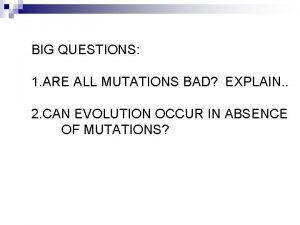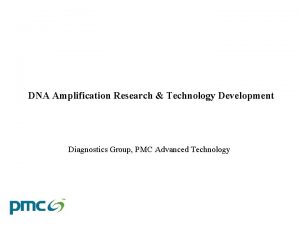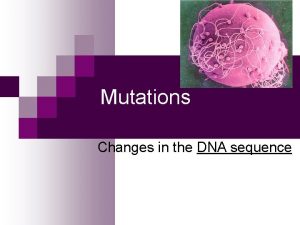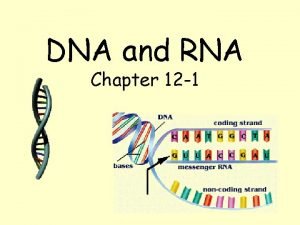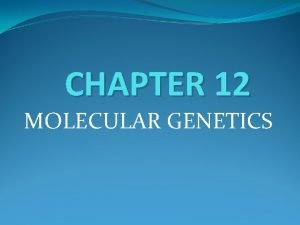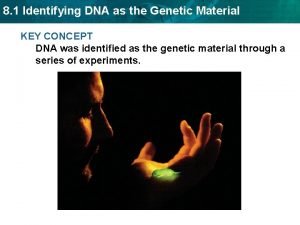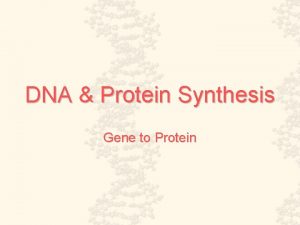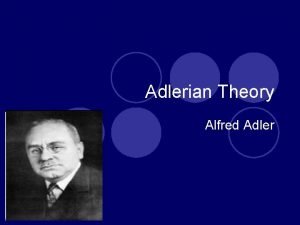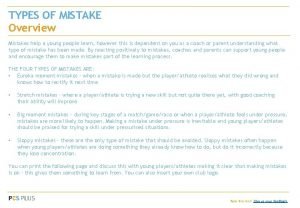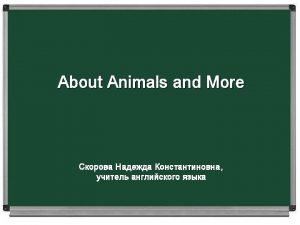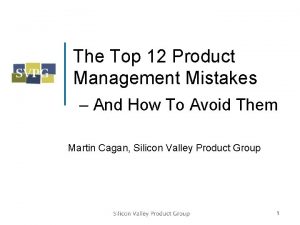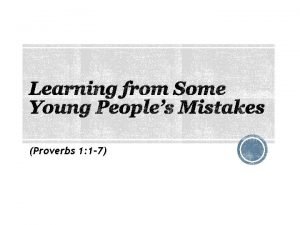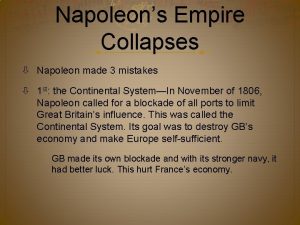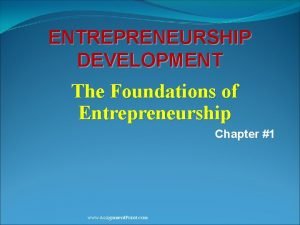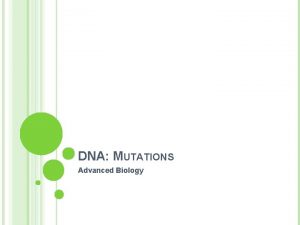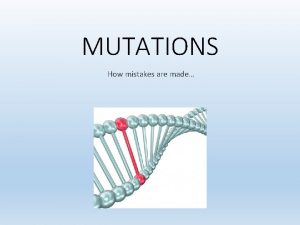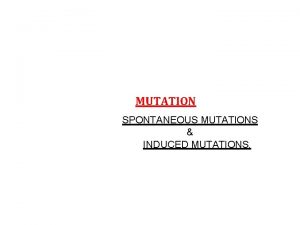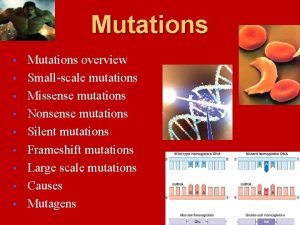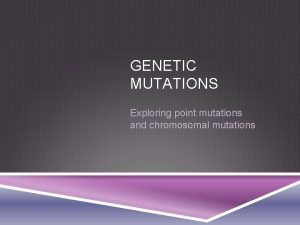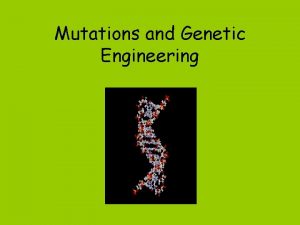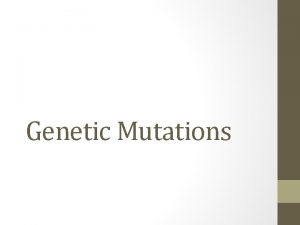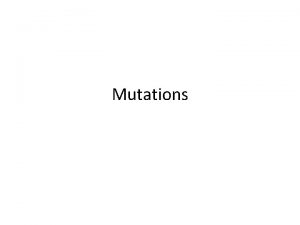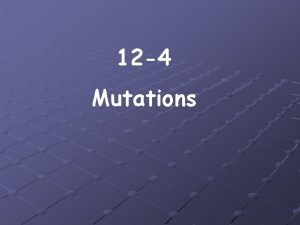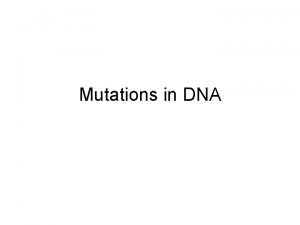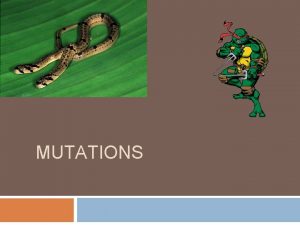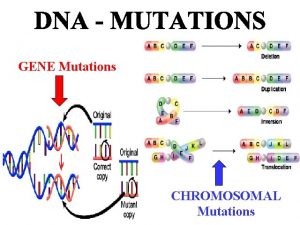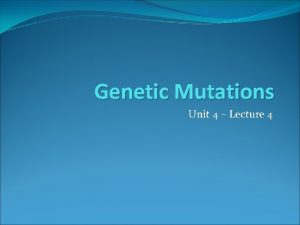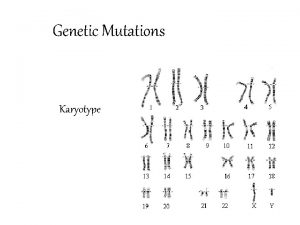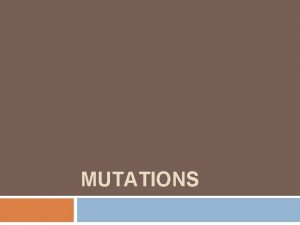Genetic Mutations Mutations Mistakes made in the DNA



























- Slides: 27

Genetic Mutations

Mutations Mistakes made in the DNA sequencing They can have a range of effects. They can affect the genetic information that is passed to offspring. Cells have evolved various methods to deal with them.

Mutations Usually mutations that only affect a single gene happen during replication. Mutations that affect a group of genes or an entire chromosome happen during meiosis

Gene Mutations A mutation that changes one gene There are two types: Point mutation Frameshift mutation

Point Mutation A type of gene mutation that occurs if one nucleotide is substituted for another May result in one or more wrong amino acids being added to a protein. Usually, this mistake is caught and fixed by DNA polymerase. If not corrected it can permanently change the DNA of an organism.

Point Mutation If you have a sentence made of 3 letter words (like codons): THE RAT HID AND THE CAT SAT AND GOT FAT. If we substitute a different letter for the R, words are still formed, but the sentence doesn’t make sense: THE PAT HID AND THE CAT SAT AND GOT FAT. SUBSTITUTION

Frameshift Mutation This mutation occurs when a nucleotide is inserted or deleted in the DNA sequence. They shift the entire sequence following them by one or more nucleotides. This shift alters how the codons are read. Can result in different amino acids being added to the protein. Usually affects a polypeptide much more than a substitution. May create a stop codon, which will stop protein synthesis resulting in shorter proteins than intended.

Frameshift Mutation If you take the same sentence as before and add or delete a letter somewhere it is even worse. Before: THE RAT HID AND THE CAT SAT AND GOT FAT. After inserting a letter: THE RAT HIX DAN DTH ECA TSA TAN DGO TFA T. Insertion After deleting a letter: THE RAH IDA NDT HEC ATS ATA NDG OTF AT. Deletion


Chromosomal Mutations This mutation changes the structure or number of chromosomes. It is caused when a chromosome or part of a chromosome is duplicated, deleted, or attached incorrectly. The structure of a chromosome can change if a part of a chromosome is broken off or lost during the processes of mitosis or meiosis.

Duplication and Deletion A broken part of a chromosome can reattach to a sister chromatid and cause duplication of genetic information in one chromatid and deletion of genetic information in the other.

Inversion A chromosomal mutation that occurs if the broken part reattaches backwards.

Translocation • A chromosomal mutation that occurs if a broken piece of a chromosome reattaches to another chromosome. • A piece of one chromosome moves to a nonhomologous chromosome. • Two nonhomologous chromosomes exchange segments with each other.

Translocation

Chromosome Mutations

Mutations during Mitosis Gene mutations can either be passed on from a parent to a child, or they can be acquired during an individual’s lifetime. When they occur during an organism’s lifetime, te mutations are usually the result of mistakes that occur during mitosis Somatic cells are reproduced during mitosis Usually these mistakes are repaired, but if not, they can cause cellular malfunctions. These mistakes are not passed on to the offspring.

Mutagens External agents that can change the DNA Some types of radiation cause mutations Some chemicals cause mutation. Mutations that cause cancer are called carcinogens. Ex: UV light increases the risk of skin cancer. Ex: Repeated exposure to radiation from x-rays can cause mutations in cells of internal organs Ex: Tobacco, asbestos, benzene, and some pesticides are common chemical carcinogens.

Mutations during Meiosis This mutation can be passed on to offspring. It becomes part of the offspring’s DNA and will be found in every cell. Gene mutations and chromosomal mutations can be passed on to offspring. Gene mutations: most are recessive, some occur on sex chromosomes. Ex: sickle cell anemia, Tay-Sach’s disease, cystic fibrosis Chromosomal Mutations: too few or too many chromosomes can be passed on to offspring. Ex: Down’s syndrome (Trisomy 21)

Mutations during Meiosis Mutations in germ cells are the underlying source of genetic variation, which is the basis of natural selection. They affect the phenotype of the offspring. Often, this effect is so harmful that the offspring do not develop properly or die before they can reproduce. Can result in less adaptive phenotypes Natural selection removes these mutant alleles from the population. Rarely, a mutation results in a more beneficial phenotype These are favored by natural selection and increase in a population.

Nondisjunction A chromosome does not separate correctly during meiosis A gamete can have extra or a missing chromosome. If the defective gamete is fertilized, the resulting individual will have some form of genetic disorder.

Nondisjunction

Downs Syndrome Trisomy 21: A person has 3 copies of chromosome 21 instead of just 2. • 47 chromosomes instead of 46 • All races • 1 in 730 babies • Increased risk if mother is over 35 (1 in 400 at age 35)(1 in 35 at age 45)

Karyotypes Can be used to see if there is an abnormal number of chromosomes or if one or more is misshapen. A sample of cells is obtained and tested. They are processed and a picture is taken of the stained chromosomes during metaphase when they are easiest to see. The picture is enlarged so the geneticist can cut the chromosomes apart and arrange them in pairs by length and location of the centromeres. From this they can see if there are too many or too few chromosomes or if there has been a chromosomal duplication, deletion, inversion, or translocation.

Male karyotype



 Are all mutations bad? explain.
Are all mutations bad? explain. Mutations in dna
Mutations in dna Dna types of mutations
Dna types of mutations Genetic programming vs genetic algorithm
Genetic programming vs genetic algorithm Genetic programming vs genetic algorithm
Genetic programming vs genetic algorithm Genetic drift
Genetic drift What is specation
What is specation Gene flow vs genetic drift
Gene flow vs genetic drift Chapter 12 dna and rna section 12-1
Chapter 12 dna and rna section 12-1 Chapter 12 section 1 dna the genetic material
Chapter 12 section 1 dna the genetic material Chapter 12 section 1 dna the genetic material
Chapter 12 section 1 dna the genetic material Chapter 12 section 1 molecular genetics answer key
Chapter 12 section 1 molecular genetics answer key Section 1 identifying dna as the genetic material
Section 1 identifying dna as the genetic material Chapter 12 section 1 molecular genetics answer key
Chapter 12 section 1 molecular genetics answer key Coding dna and non coding dna
Coding dna and non coding dna Enzyme involved in dna replication
Enzyme involved in dna replication Dna rna protein synthesis homework #2 dna replication
Dna rna protein synthesis homework #2 dna replication Bioflix activity dna replication dna replication diagram
Bioflix activity dna replication dna replication diagram Dna polymerase function in dna replication
Dna polymerase function in dna replication The spools from which the dna unwinds is made of what
The spools from which the dna unwinds is made of what Alfred adler theory
Alfred adler theory Types of mistake
Types of mistake Look and find the mistakes
Look and find the mistakes Biggest mistakes product management
Biggest mistakes product management Proverbs 1:5-7
Proverbs 1:5-7 Napoleons 3 mistakes
Napoleons 3 mistakes Top 10 mistakes pastors make
Top 10 mistakes pastors make Assignment on entrepreneurship development
Assignment on entrepreneurship development
